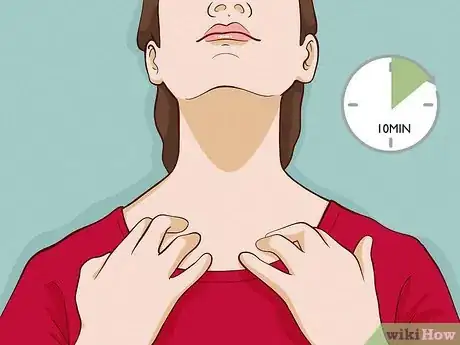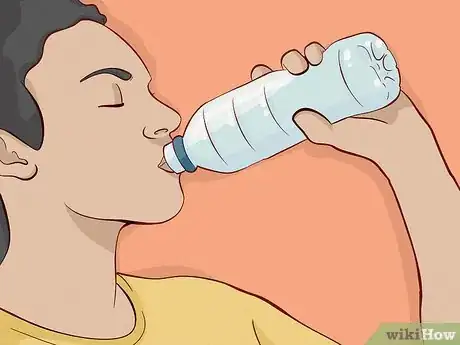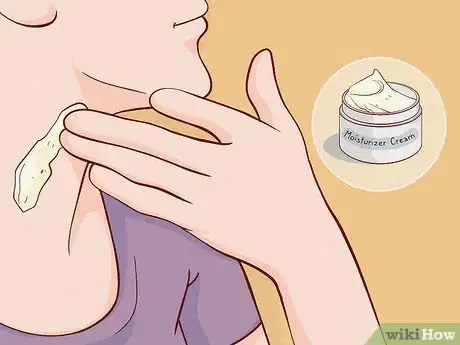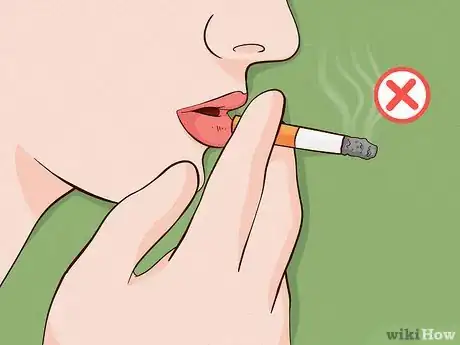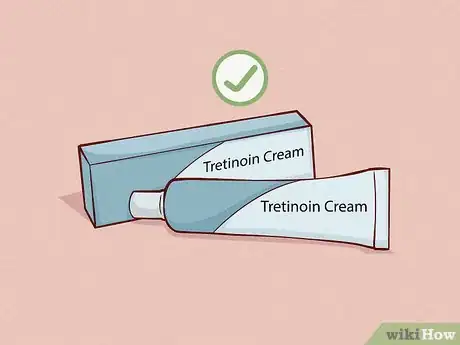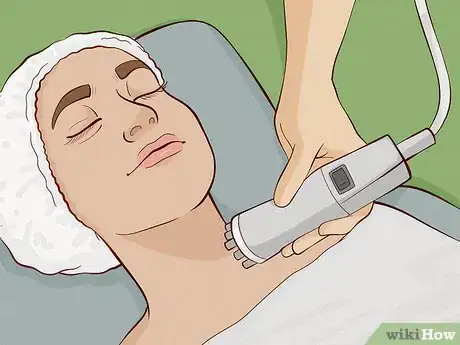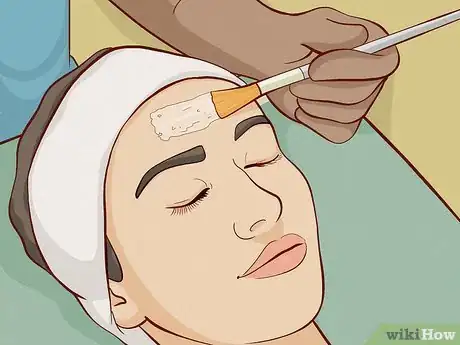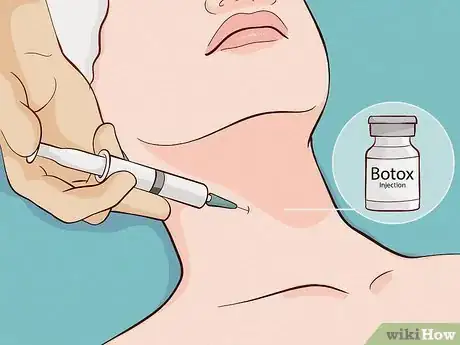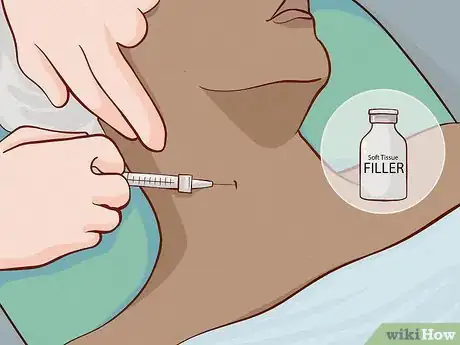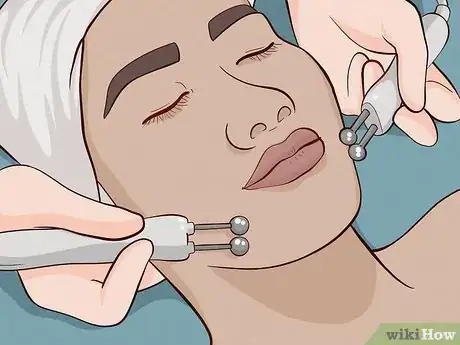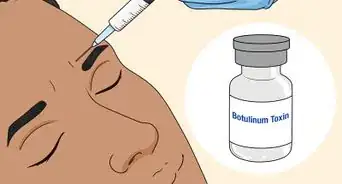This article was co-authored by Mohiba Tareen, MD. Mohiba Tareen is a board certified Dermatologist and the founder of Tareen Dermatology located in Roseville, Maplewood and Faribault, Minnesota. Dr. Tareen completed medical school at the University of Michigan in Ann Arbor, where she was inducted into the prestigious Alpha Omega Alpha honor society. While a dermatology resident at Columbia University in New York City, she won the Conrad Stritzler award of the New York Dermatologic Society and was published in The New England Journal of Medicine. Dr. Tareen then completed a procedural fellowship which focused on dermatologic surgery, laser, and cosmetic dermatology.
wikiHow marks an article as reader-approved once it receives enough positive feedback. This article received 15 testimonials and 100% of readers who voted found it helpful, earning it our reader-approved status.
This article has been viewed 1,536,858 times.
One of the most obvious signs of aging is the lack of firmness in the skin. As we age our skin loses the elasticity that it had in our younger years, and this causes it to become loose and appear saggy. This process is often most obvious on the face and neck. Although you cannot turn back the hands of time, you can be proactive and try different home and medical treatments to tighten your loosening neck skin.
Steps
Firming Your Neck Skin through Lifestyle
-
1Exercise your facial and neck muscles. There are several exercises that provide a good mix of stretching and working out your neck and lower facial muscles. Repeat them once or twice a day and this may strengthen your neck so that it appears firmer.
- Place one hand on your forehead. Push your head against it without letting it go forwards. You should feel your neck muscles working. Hold this position for about 10 seconds. Then clasp your hands behind your head, and push backwards to create pressure, and again hold for about ten seconds.
- Sit down with your back straight. Lift your head back so that your chin is pointing toward the ceiling with your lips closed. Next make a chewing motion with your mouth. You'll feel your neck and facial muscles being worked. Repeat about 20 times.
- Again, sit with a straight back and lift your head so that your chin points to the ceiling with your lips together. This time, pout your lips in a sort of kissing motion. Repeat this exercise twice. This may feel similar to the first exercise, but actually works different parts of your neck and face.
- Be careful with this one because it could strain your neck. Lie on the bed with your head hanging over the edge. Slowly and carefully lift your head up towards your torso, using your neck. Slowly and carefully lower it back down. Repeat this about 5 times. Stop immediately if you feel any pain.
-
2Avoid repeated facial expressions. Certain facial movements and expressions, such as tilting your head in disagreement, can weaken adjacent muscles. Observe any repeated facial gestures you may make to help keep your neck skin firm longer.
- Whenever you use facial or neck muscles, it causes a groove to form under your skin. As your skin loses elasticity over time, it can no longer fill this grove and may cause a permanent wrinkle or flap on your neck.
Advertisement -
3Eat a healthy diet. There is some evidence that a nutritionally well-balanced diet may protect your skin. Avoiding unhealthy and junk foods may help keep wrinkles and loss of elasticity at bay.
- Diets high in fat and sugar may slow cell turnover. Try not to eat too many fried foods or sweets — limit your simple sugar intake and instead focus on complex carbohydrates.
- Foods high in vitamin A and beta-carotene, including fruits and vegetables such as raspberries and carrots, may increase cell turnover for healthier skin.
- Yellow and orange fruits and vegetables are high in vitamin A and beta-carotene. These, combined with plenty of water, increase cell turnover resulting in healthy skin that is not prone to clog-causing damage.
- Food high in essential fatty acids (alpha-linolenic and linoleic fatty acids), such as walnuts or olive oil, may help skin cells stay hydrated.
- Unhealthy foods also take the place of foods you could be eating that provide the necessary vitamins and antioxidants to promote healthy skin.
-
4Stay hydrated. Skin that is hydrated is generally more plump and firm and less likely to sag or wrinkle. Making sure you consume enough liquids every day can help you tighten your neck skin.
- You should consume at least nine cups of water a day to stay hydrated if you are a woman and 13 cups if you are a man. Athletes and pregnant women require up to 16 cups of water a day.[1]
- Water is the best choice for your needs, but you can also drink non-caffeinated tea, and juices diluted with water.
- You may consume coffee or caffeinated teas and soft drinks in limited quantities, but be aware that they may dehydrate you slightly.
-
5Apply moisturizer daily. Use a skin-type specific moisturizer that boosts collagen and elastin production every day. Having properly hydrated skin can help make your neck skin firmer.
- Even if your skin is oily, it may need a moisturizer. Choose an oil-free and non-comedogenic product.
- Seek the advice of a dermatologist or skincare professional to help assess what type of skin you have. You can buy products specifically formulated for your skin type and needs at most pharmacies and at many retailers, including department stores.
- There are many products that can not only boost collagen and elastin production, but may also improve the appearance of your neck skin by plumping it up with products such as silicone and hyaluronic acid.
- Using a moisturizer with a built in sunscreen may increase the skin firming benefits.
- Apply moisturizer every day when you get out of the shower.[2]
-
6Limit exposure to the sun. Ultraviolet radiation, which is present in the sun’s rays, speeds the natural aging process.[3] Reducing or avoiding sun exposure may help your skin retain its firmness longer.
- Wear a broad spectrum, high SPF (at least 30) sunscreen for times when you are outside running errands or doing other activities.
- You can also wear a hat with a wide brim to further help protect your skin from sun exposure.
- If you go to the beach or pool, consider sitting under an umbrella. Use a water-resistant sunscreen.
-
7Quit smoking. Like sun exposure, smoking accelerates the natural aging process.[4] Quit or reduce your smoking habit to stop the aging process in your skin, which may help it stay firmer longer.
- Speak to your doctor if you are having difficulties quitting smoking. She can help you develop an effective treatment plan.
-
8Avoid sudden weight gain or loss. Weight gain can cause your skin to stretch and will leave you with looser skin if you lose the weight. Sudden weight loss doesn't give your skin time to adjust and will leave it looking and feeling loose. Maintain your current weight or lose weight gradually to avoid sagging neck skin.
Achieving Tighter Skin with Medical Treatments
-
1Administer topical retinoids. Retinoids are vitamin A derivatives that may improve fine wrinkles, splotches and skin roughness. Administering a topical retinoid that your doctor prescribes may help improve the appearance of your neck skin and help improve its elasticity.[5]
- Tretinoin and tazarotene are two types of retinoids your doctor may prescribe.[6]
- You need a prescription for a retinoid from your doctor, so consult with her to make sure this is a viable option for you.[7]
- When applying retinoids to the face for palliation of fine wrinkles, apply a pea-size amount of cream once daily at bedtime or in the evening.
- Be aware of sensitivity to UVA light when using this medication. Minimize exposure to sunlamps or sunlight.
- Be aware that some insurance companies will not cover retinoids used for cosmetic purposes.
- There are some skin creams available over-the-counter that have low grade retinoids in them. Be aware that these are not as powerful as prescription retinoids and may not improve your skin over the long-term.[8]
- Retinoids can cause redness, dryness, and burning on your skin.[9]
-
2Undergo laser, light source or radiofrequency therapy. Using treatments derived from laser, light sources, or radiofrequency can stimulate the growth of new collagen in your skin.[10] Undergo one of these treatments to help firm your neck skin.
- Laser and light source treatments destroy the outer layer of the skin and heat the underlying layer to stimulate collagen growth. As your wounded skin heals, it forms smoother and tighter skin.[11]
- It can take several months to fully heal from light source or laser resurfacing and it runs risks such as scarring, or lightening or darkening of your skin.[12]
- Consider nonablative laser treatments for skin that is less saggy.[13]
- Radiofrequency treatments are also nonablative to consider. Although you won’t achieve the same results as with laser or light source therapy, you may still notice mild to moderate skin tightening.[14]
- Be aware that most insurance companies will not cover these treatments for cosmetic purposes.
-
3Peel away layers of skin. There are less invasive treatments that can peel away layers of the skin. Chemical peels, dermabrasion and microdermabrasion remove the outer layer of your skin and may help not only improve elasticity, but also appearance.[15]
- A chemical peel requires that your doctor apply an acid to the top layer of your skin. This will burn away the skin on the affected area along with some wrinkles, fine lines, and freckles.[16] It can take several weeks to heal from a chemical peel and may require several treatments to see results.[17]
- Dermabrasion will sand away the surface layer of your skin with a rotating brush.[18] This will stimulate the production of a new layer of skin, which may make your neck skin firmer.[19] It can take months to see results and fully heal from the procedure.[20]
- Microdermabrasion is similar to dermabrasion, but only remove a small layer of skin. It may take several treatments to see results with dermabrasion, but your overall healing time will be lower than with alternatives.[21] Microdermabrasion also only produces modest results.[22]
- Be aware that most insurance companies will not cover these treatments for cosmetic purposes.
-
4Get Botox injections. Botox, which is the Botulinum toxin type A, can keep muscles from contracting, making the skin appear smoother and less wrinkled.[23] Get Botox injections for mild skin sagging to help firm your neck skin.[24]
- Botox lasts for three to four months and needs repeat injections to maintain your results.[25]
- One of the side effects of Botox is an inability to move your face and neck muscles. Be aware that this can limit how well you can express your emotions.
- Be aware that most insurance companies will not cover Botox injected for cosmetic purposes.
-
5Inject soft tissue fillers. There are different types of fillers for soft tissues, including fat, collagen, and hyaluronic acid. Have these injected into your neck area to help plump up and firm your neck skin.[26]
- You may have some swelling, redness and bruising from soft filler injections.[27]
- Like Botox or microdermabrasion, you may need to get repeat injections because most fillers only last for a few months.[28]
- Be aware that most insurance companies will not cover filler injections for cosmetic purposes.
-
6Consider a surgical facelift. If you have extremely saggy skin on your neck, surgery is an option. This is the most extreme form of treatment to tighten your skin and you should only consider it if absolutely necessary or other options don’t work.
- As with all cosmetic surgery, make sure that you are fully aware of the risks involved and consult a trusted surgeon and company.
- A facelift will require removing excess skin and fat from your neck and then tightening the muscle and connective tissue underneath.
- It can take a long time to heal from a facelift, and you may bruising and swelling for many weeks after the procedure.[29]
- Results can last for five to 10 years.[30]
- After surgery try to wear comfortable clothing that you can pull over you head very easily and comfortably. Have pillows available to prop your head and neck up in a good position. Have someone stay with you at least 24 hours after surgery. [31]
- Quit smoking completely and stop taking blood thinners (with the guidance of your doctor) before surgery. Smoking cessation is necessary for proper healing, and blood thinners increase your risk of bleeding during surgery.[32]
- Be aware that most insurance companies will not cover face lifts for cosmetic purposes.
Expert Q&A
Did you know you can get expert answers for this article?
Unlock expert answers by supporting wikiHow
-
QuestionWhat are some ingredients I should look for in a moisturizer?
 Mohiba Tareen, MDMohiba Tareen is a board certified Dermatologist and the founder of Tareen Dermatology located in Roseville, Maplewood and Faribault, Minnesota. Dr. Tareen completed medical school at the University of Michigan in Ann Arbor, where she was inducted into the prestigious Alpha Omega Alpha honor society. While a dermatology resident at Columbia University in New York City, she won the Conrad Stritzler award of the New York Dermatologic Society and was published in The New England Journal of Medicine. Dr. Tareen then completed a procedural fellowship which focused on dermatologic surgery, laser, and cosmetic dermatology.
Mohiba Tareen, MDMohiba Tareen is a board certified Dermatologist and the founder of Tareen Dermatology located in Roseville, Maplewood and Faribault, Minnesota. Dr. Tareen completed medical school at the University of Michigan in Ann Arbor, where she was inducted into the prestigious Alpha Omega Alpha honor society. While a dermatology resident at Columbia University in New York City, she won the Conrad Stritzler award of the New York Dermatologic Society and was published in The New England Journal of Medicine. Dr. Tareen then completed a procedural fellowship which focused on dermatologic surgery, laser, and cosmetic dermatology.
FAAD Board Certified Dermatologist
-
QuestionHow do I get rid of jowls?
 Chris M. Matsko, MDDr. Chris M. Matsko is a retired physician based in Pittsburgh, Pennsylvania. With over 25 years of medical research experience, Dr. Matsko was awarded the Pittsburgh Cornell University Leadership Award for Excellence. He holds a BS in Nutritional Science from Cornell University and an MD from the Temple University School of Medicine in 2007. Dr. Matsko earned a Research Writing Certification from the American Medical Writers Association (AMWA) in 2016 and a Medical Writing & Editing Certification from the University of Chicago in 2017.
Chris M. Matsko, MDDr. Chris M. Matsko is a retired physician based in Pittsburgh, Pennsylvania. With over 25 years of medical research experience, Dr. Matsko was awarded the Pittsburgh Cornell University Leadership Award for Excellence. He holds a BS in Nutritional Science from Cornell University and an MD from the Temple University School of Medicine in 2007. Dr. Matsko earned a Research Writing Certification from the American Medical Writers Association (AMWA) in 2016 and a Medical Writing & Editing Certification from the University of Chicago in 2017.
Family Medicine Physician
References
- ↑ http://www.mayoclinic.org/healthy-lifestyle/nutrition-and-healthy-eating/in-depth/water/art-20044256?pg=2
- ↑ Mohiba Tareen, MD. FAAD Board Certified Dermatologist. Expert Interview. 26 March 2020.
- ↑ Mohiba Tareen, MD. FAAD Board Certified Dermatologist. Expert Interview. 26 March 2020.
- ↑ Mohiba Tareen, MD. FAAD Board Certified Dermatologist. Expert Interview. 26 March 2020.
- ↑ http://www.mayoclinic.org/diseases-conditions/wrinkles/basics/treatment/con-20029887
- ↑ http://www.mayoclinic.org/diseases-conditions/wrinkles/basics/treatment/con-20029887
- ↑ http://www.mayoclinic.org/diseases-conditions/wrinkles/basics/treatment/con-20029887
- ↑ http://www.mayoclinic.org/diseases-conditions/wrinkles/basics/treatment/con-20029887
- ↑ http://www.mayoclinic.org/diseases-conditions/wrinkles/basics/treatment/con-20029887
- ↑ http://www.mayoclinic.org/diseases-conditions/wrinkles/basics/treatment/con-20029887
- ↑ http://www.mayoclinic.org/diseases-conditions/wrinkles/basics/treatment/con-20029887
- ↑ http://www.mayoclinic.org/diseases-conditions/wrinkles/basics/treatment/con-20029887
- ↑ http://www.mayoclinic.org/diseases-conditions/wrinkles/basics/treatment/con-20029887
- ↑ http://www.mayoclinic.org/diseases-conditions/wrinkles/basics/treatment/con-20029887
- ↑ http://www.mayoclinic.org/diseases-conditions/wrinkles/basics/treatment/con-20029887
- ↑ http://www.mayoclinic.org/diseases-conditions/wrinkles/basics/treatment/con-20029887
- ↑ http://www.mayoclinic.org/diseases-conditions/wrinkles/basics/treatment/con-20029887
- ↑ http://www.mayoclinic.org/diseases-conditions/wrinkles/basics/treatment/con-20029887
- ↑ http://www.mayoclinic.org/diseases-conditions/wrinkles/basics/treatment/con-20029887
- ↑ http://www.mayoclinic.org/diseases-conditions/wrinkles/basics/treatment/con-20029887
- ↑ http://www.mayoclinic.org/diseases-conditions/wrinkles/basics/treatment/con-20029887
- ↑ http://www.mayoclinic.org/diseases-conditions/wrinkles/basics/treatment/con-20029887
- ↑ http://www.mayoclinic.org/diseases-conditions/wrinkles/basics/treatment/con-20029887
- ↑ http://www.mayoclinic.org/diseases-conditions/wrinkles/basics/treatment/con-20029887
- ↑ http://www.mayoclinic.org/diseases-conditions/wrinkles/basics/treatment/con-20029887
- ↑ http://www.mayoclinic.org/diseases-conditions/wrinkles/basics/treatment/con-20029887
- ↑ http://www.mayoclinic.org/diseases-conditions/wrinkles/basics/treatment/con-20029887
- ↑ http://www.mayoclinic.org/diseases-conditions/wrinkles/basics/treatment/con-20029887
- ↑ http://www.mayoclinic.org/diseases-conditions/wrinkles/basics/treatment/con-20029887
- ↑ http://www.mayoclinic.org/diseases-conditions/wrinkles/basics/treatment/con-20029887
- ↑ http://www.webmd.com/beauty/treatments/cosmetic-procedures-neck-lift?page=2
- ↑ http://www.webmd.com/beauty/treatments/cosmetic-procedures-neck-lift?page=2
About This Article
To tighten loose neck skin, try doing facial exercises such as chin lifts and stretches to strengthen your neck muscles. You can also prevent the loss of elasticity in your neck by avoiding repeated facial movements, such as tilting your head to the same side. Additionally, sticking to a healthy diet that’s low in sweets and fried foods but high in healthy fats, fruits, and vegetables can help to keep wrinkles at bay. Remember to drink at least 9 cups of water every day to keep your skin hydrated, plump, and firm! For more tips from our Medical reviewer, including what medical treatments might help tighten your loose skin, scroll down!
